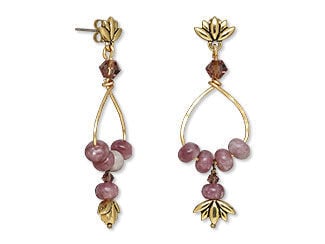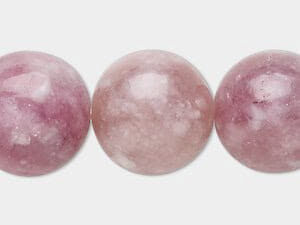Lepidolite Meaning and Properties
Lepidolite History
Lepidolite was first discovered in 1861 by Robert Bunsen and Gustav Kirchhoff. Originally called "lilalite" because of its lavender color, it was later named "lepidolite" from the Greek λείπω (leipo)—which means "scale"—because of its scaly appearance caused by flakes of lithium.
Lepidolite is mined as a source of the element lithium along with other rare earth elements such as cesium and rubidium. Lepidolite is an important source of lithium, which is the lightest metal in the world. It is used in rechargeable batteries, mobile phones, toasters, microwave ovens, air purifiers and aircraft parts and is well-known as a mood-stabilizing drug. Fine-grained masses of lepidolite have been polished into ornaments such as eggs and animal carvings.
What are the Metaphysical Properties of Lepidolite?
Lepidolite is sometimes called the "peace stone" or "grandmother stone" because it is thought to have nurturing and calming properties. Within the metaphysical realm, lepidolite meaning is linked to overcoming emotional or mental dependency and helping treat addictions and all kinds of conditions, including anorexia. It is also thought to help those with bipolar disorder because of its mind-balancing properties. Lepidolite meaning is associated with alleviating feelings of stress and nervous conditions while opening the mind and calming the higher self.
Lepidolite is associated with the zodiac sign of Libra and the 7th chakra in the traditional Hindu belief system. The 7th chakra is positioned on the crown of the head and is linked to the brain and central nervous system.
What is Lepidolite Made From?
Lepidolite is a translucent to transparent rose to purple colored phyllosilicate mineral of the mica group. Lepidolite is associated with other lithium-bearing minerals like spodumene in pegmatite bodies. It is one of the major sources of the rare alkali metals rubidium and cesium. It is found most often as small, scaly crystals in dense aggregates. It is also found in masses and groupings such as foliated, flaky and scaly forms. Large crystals, which are in stubby pseudohexagonal form, are much rarer than the other micas. It is also found in rounded ball-shaped aggregates and in massive form with tiny glittery crystals. Major sources of lepidolite are Brazil, Russia, Afghanistan, United States (California), Canada and Madagascar.
- Mineral Information: Basic potassium lithium aluminum fluoro-silicate
- Chemical Composition: K(Li,Al)3(Al,Si,Rb)4O10(F,OH)2
- Color: Pink to purple, also lesser-common rose-red, violet-gray, yellowish, white, colorless
- Hardness: 2-1/2 to 3 (Mohs)
- Specific Gravity: 2.8 - 2.9
- Refractive Index: 1.611 - 1.669
How Do You Clean Lepidolite?
Lepidolite should be kept away from harsh household chemicals. Clean lepidolite with warm, soapy water. Rinse off any soapy residue and wipe using only a soft cloth. It is advisable to remove any lepidolite gems or jewelry before exercising, playing sports or engaging in other vigorous activities such as household chores. To prevent scratches and fractures, lepidolite should be stored separately from other gems and jewelry. For extra protection, wrap lepidolite jewelry using a soft cloth and place into a fabric-lined jewelry box.
Lepidolite FAQ
Q: What gives lepidolite its color?
A: Trace amounts of manganese give lepidolite it’s soft, delicate pink hue.
Q: Is lepidolite a birthstone?
A: While lepidolite is not an official birthstone, because of its pink and purple color, it can be used alongside or as a substitute for amethyst (February).
Q: Is it true that lepidolite has an eco-connection?
A: Lepidolite is the main source of lithium, which is used in various renewable energy applications.
Designing with Lepidolite
With its variety of hues from pinkish rose to purple along with other shades, lepidolite offers more tonal flexibility than you might think at first glance. For a slight contrast, consider pairing lepidolite with the lighter rose quartz. Complementary colors such as the pale green of chrysoprase will produce a light and pleasing palette as seen in a nature-inspired necklace featuring green leaves and pinkish oval-shaped flowers.
A Design Inspiration to Get You Started
Shop for Lepidolite
**Please note that all metaphysical or healing properties listed are collected from various sources. This information is offered as a service and not meant to treat medical conditions. Fire Mountain Gems and Beads® does not guarantee the validity of any of these statements.
How did you like this resource? Your feedback helps us provide resources that matter to you most.
Copyright Permissions
All works of authorship (articles, videos, tutorials and other creative works) are from the Fire Mountain Gems and Beads® Collection, and permission to copy is granted for non-commercial educational purposes only. All other reproduction requires written permission. For more information, please email copyrightpermission@firemtn.com.


